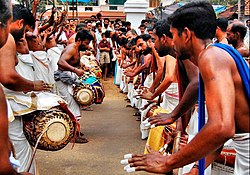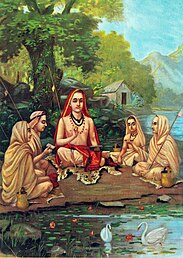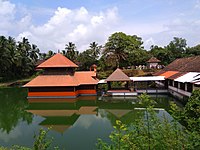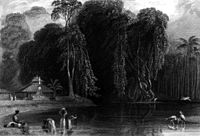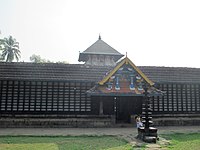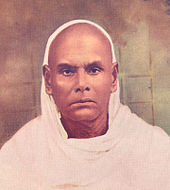The following outline is provided as an overview of and topical guide to Hinduism:
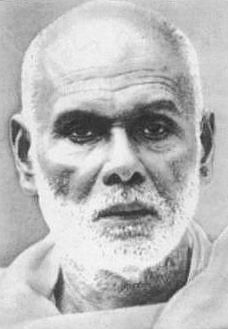
Sree Narayana Guru was a philosopher, spiritual leader and social reformer in India. He led a reform movement against the injustice in the caste-ridden society of Kerala in order to promote spiritual enlightenment and social equality. A quote of his that has become popular: "one caste, one religion, and one god for all men". He is the author of the Advaita poem Daiva Dasakam, which is one of the most used poem in Kerala for community prayer.
Kalady or Kaladi is a town located between Angamaly and Perumbavoor, east of the Periyar river, near to Malayattoor in Ernakulam district of Kerala, India, not far from Cochin International Airport. It is notable as the birthplace of 9th century Indian philosopher Adi Shankara.
Sampradaya, in Indian origin religions, namely Hinduism, Buddhism, Jainism, and Sikhism, can be translated as 'tradition', 'spiritual lineage', 'sect', or 'religious system'. To ensure continuity and transmission of dharma, various sampradayas have the Guru-shishya parampara in which parampara or lineage of successive gurus (masters) and shishyas (disciples) serves as a spiritual channel and provides a reliable network of relationships that lends stability to a religious identity. Shramana is vedic term for seeker or shishya. Identification with and followership of sampradayas is not static, as sampradayas allows flexibility where one can leave one sampradaya and enter another or practice religious syncretism by simultaneously following more than one sampradaya. Samparda is a punjabi language term, used in Sikhism, for sampradayas.

The Guruvayur Temple is a famous Indian Hindu temple located in the town of Guruvayur in Thrissur district, Kerala. The temple is dedicated to Lord Vishnu (Guruvayurappan) but popularly known as Krishna. It is one of the most important places of worship for Hindus in Kerala and Tamil Nadu and is often referred to as Bhuloka Vaikuntha. The temple is Classified one among the 108 Abhimana Kshethram of Vaishnavate tradition.

The Smartatradition, also called Smartism, is a movement in Hinduism that developed and expanded with the Puranas genre of literature. It reflects a synthesis of four philosophical strands, namely Uttara Mīmāṃsā, Advaita, Yoga, and theism. The Smarta tradition rejects theistic sectarianism, and is notable for the domestic worship of five shrines with five deities, all treated as equal – Ganesha, Shiva, Shakti, Vishnu and Surya. The Smarta tradition contrasted with the older Shrauta tradition, which was based on elaborate rituals and rites. There has been a considerable overlap in the ideas and practices of the Smarta tradition with other significant historic movements within Hinduism, namely Shaivism, Brahmanism, Vaishnavism, and Shaktism.

The Vadakkumnathan Temple is an ancient Hindu temple dedicated to Shiva in Thrissur, in the Thrissur district of Kerala, India. The temple is a classical example of the architectural style of Kerala and has one monumental tower on each of the four sides in addition to a koothambalam. Mural paintings depicting various scenes from the Mahabharata can be seen inside the temple. The shrines and the Kuttambalam display vignettes carved in wood. The temple, along with the mural paintings, has been declared as a National Monument by India under the AMASR Act. According to popular local lore, this is the first temple built by Parashurama, the sixth avatar of Vishnu. Thekkinkadu Maidan, encircling the Vadakkumnathan Temple, is the main venue of the renowned Thrissur Pooram festival.

Dasanami (IAST: Daśanāmī Saṃpradāya "Tradition of Ten Names"), also known as the Order of Swamis, is a Hindu monastic tradition of "single-staff renunciation" generally associated with the four cardinal mathas of the Advaita Vedanta tradition and, according to tradition, organized in its present form by Vedic scholar and teacher Adi Shankaracharya.

Mani Damodara Chakyar is a Kutiyattam and Chakyar Koothu artist in Kerala state of south India. He is a nephew and disciple of legendary guru Nātyāchārya Vidūshakaratnam Padma Shri Māni Mādhava Chākyār. He belongs to the great Mani Chakyar tradition of Koodiyattam and Chakyar koothu.

Dakshinamurti is an aspect of the Hindu god Shiva as a guru (teacher). He is regarded to be the personification of the supreme or the ultimate awareness, understanding, and knowledge. Dakshinamurti represents Shiva as a teacher of yoga, music, and wisdom, offering an exposition of the Shastras. He is worshipped as the god of wisdom and meditation.

Narayana Guru built temples at various locations in India: Kollam, Thiruvananthapuram, Thrissur, Kannur, Anchuthengu, Thalassery, Kozhikode, Mangalore. Some of the temples built by the guru are:

Thrikkadavoor is a town and a neighbourhood of Kollam city in the state of Kerala, India. It is located approximately 5 kilometres north of Kollam city centre and 30 kilometres away from Paravur, Thrikkadavoor has become a bustling urban center, and is now home to educational institutions, five star hotel, local business establishments and major recent real estate ventures
Thrikkadavoor was a separate panchayath till 2015. In May 2015, Government of Kerala have decided to expand City Corporation of Kollam by merging Thrikkadavoor panchayath.
Irumkulangara Durga Bhagavathi Temple is a Hindu temple in Thottam, Manacaud P.O, Thiruvananthapuram, Kerala, India. It is about 1.8 kilometres to the southwest of Sree Padmanabhaswamy Temple in Thiruvananthapuram city.
Hinduism, Islam and Christianity are the prominent religions in Kollam district. As per the Census 2011, out of the total population of 2,635,375 persons, 64.42% follow Hinduism, 19.30% follow Islam and 16.00% follow Christianity. Other religions comprise 0.04%, while 0.25% did not state any religion.

The Advaita Guru-Paramparā is the traditional lineage (parampara) of divine, Vedic and historical teachers of Advaita Vedanta. It begins with the Daiva-paramparā, the gods; followed by the Ṛṣi-paramparā, the Vedic seers; and then the Mānava-paramparā, with the historical teachers Gaudapada and Adi Shankara, and four of Shankara's pupils. Of the five contemporary acharyas, the heads of the five Advaita mathas, four acharyas trace their lineage to those four pupils and one to Adi Shankara himself.
Ezhava is a caste in Kerala. Shiva is a Hindu god. Siva idol was consecrated by social reformer Sree Narayana Guru at Aruvippuram, in 1888. Ezhava Siva refers not to Siva as God but to the tongue-in-cheek reply given by Sree Narayana Guru when questioned by a group of Brahmins about the legitimacy of a non Brahmin consecrating a temple. This was a major break from tradition as installation of idols by non Brahmins was considered blasphemy and Sree Narayana Guru belonged to the lower caste Ezhava community. The sarcasm was meant to highlight the immorality of Brahmins who denied social spaces and the right to worship from the lower castes.
The Thalassery carnival, the Beach fest in Muzhappilangad beach and Dharmadam beach are notable attractions. The area's four rivers around Thalassery town and four beaches with more in Kannur also attract visitors.

Niranam Thrikkapaleeswaram Dakshinamurthy Temple, an ancient Hindu temple dedicated to Lord Shiva is situated on the banks of the Pampa river at Niranam of Pathanamthitta District in Kerala state in India. This temple is a classic example of the Dravidian style of architecture. The temple is the abode of Dakshinamurthy. The deity of Thrikkapaleeswaram is located in main Sanctum Sanctorum facing east. According to folklore, sage Parasurama has installed the idol. The temple is a part of the 108 famous Shiva temples in Kerala. This is one of the three Thrikkapaleeswaram temples mentioned in 108 Shiva temples. Two other temples situated in Peralassery in Kannur district and Nadapuram in Kozhikode district.
Religious education in Kerala was historically influenced by traditional Indian religions like Hinduism, Buddhism and Jainism through the ancient education system of Gurukula. Abrahamic religions were practiced in Kerala through the early days of maritime trade. Buddhism added educational vocabulary, including Namostu Jinatam, Ezhuthu Palli, and Pallikoodam to the Malayalam language. Madrasa institutions, coordinated by various Madarasa education boards referred to as Othupalli or Palli Dar since the independence of India. Modern Christian education began in the early 19th century.
